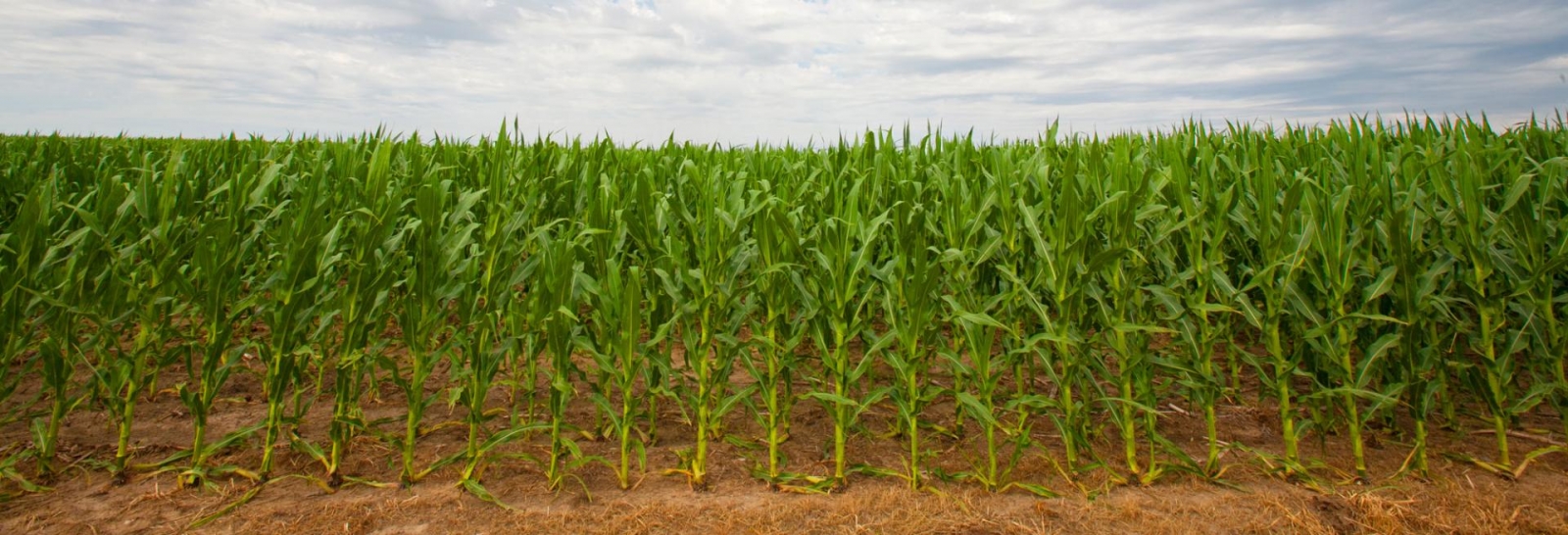Introduction
Soil amendments are any materials that when added to soil will improve its properties and processes. Amendments such as lime, gypsum, manure, or biochar can provide many benefits to production systems by improving soil chemical, physical, and biological properties. Some examples of production benefits from amendments include raising pH, adding nutrients, increasing soil organic matter, mitigating salt-affected soils, and improving soil water storage.
Soil amendments may be broadly categorized into organic and inorganic based on their sources. In addition to consideration of its availability and associated cost, a soil amendment needs to be chosen with an understanding of the soil problems that one is trying to alleviate or address with it.
Manure
Manure management to increase soil nutrients has been explored in the UNL NebGuide, Determining Crop Available Nutrients from Manure (G1335, Shapiro et al, 2015). In the UNL historic Knorr-Holden Plot at Mitchell, Nebr., cattle manure has been demonstrated to be a viable nutrient source to achieve high yield for continuous irrigated corn (Figure 1).
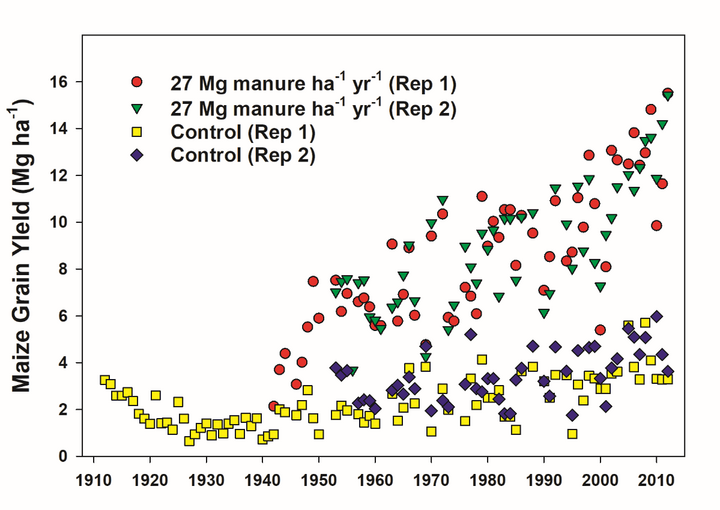
The Knorr-Holden Plot was started in 1912 and the annual treatment of cattle manure at 27 Mg ha-1 was introduced in 1942. In 2013, manured soils were found to be slightly less susceptible to compaction, including at higher soil water contents (Blanco-Canqui et al., 2015). Manured plots also retained about 16% more plant available water compared with non-manured plots and had twice as much soil organic carbon concentration, which was negatively correlated (r > −0.77) with soil compactibility and positively correlated (r > 0.72) with water retention. Overall, 71 years of manure application reduced compactibility and increased water retention in this semiarid soil.
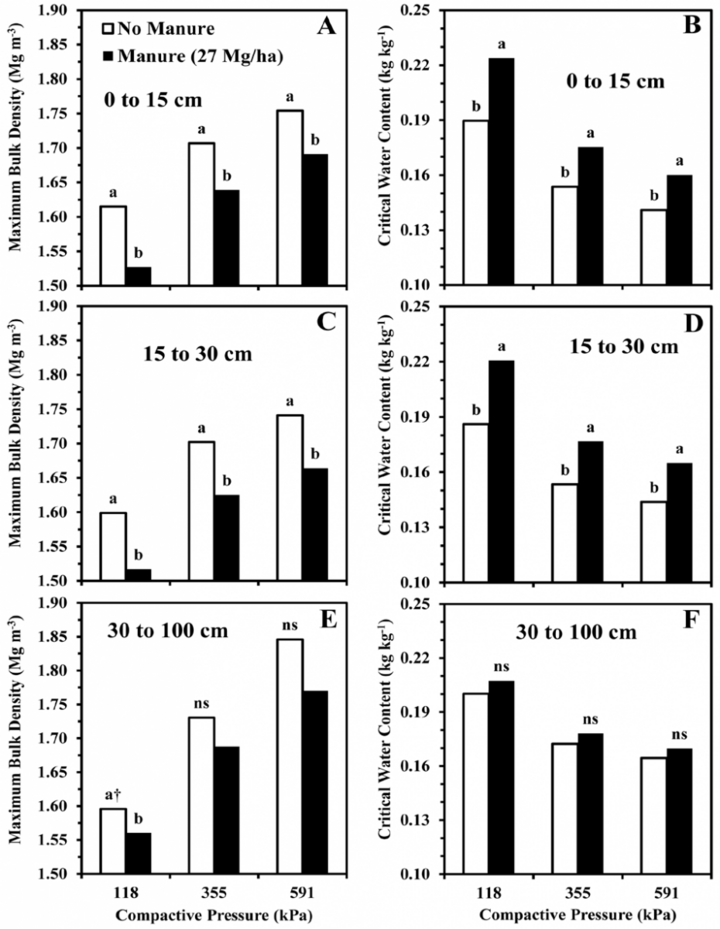
In eastern Nebraska on silt loam soil, runoff and soil loss to erosion were reduced by about 50% during three years of composted feedlot manure application and due to the residual effect during six years following application (Figure 3; Wortmann and Walters, 2006, 2007).
However, manure use needs to be appropriately used and benefits are greatest when well targeted to specific field conditions. For example, manure application generally had little effect on soil aggregation when soil aggregation was already high (Wortmann and Shapiro, 2008). Manure use is credited with high productivity in the Sandhills but there is also evidence of excessive application causing water repellency with poor infiltration and prolonged ponding in depression areas. Benefits can be great with manure application on once eroded hillsides. Manure is a valuable nutrient source but over-application has resulted in groundwater contamination and excessive P runoff.
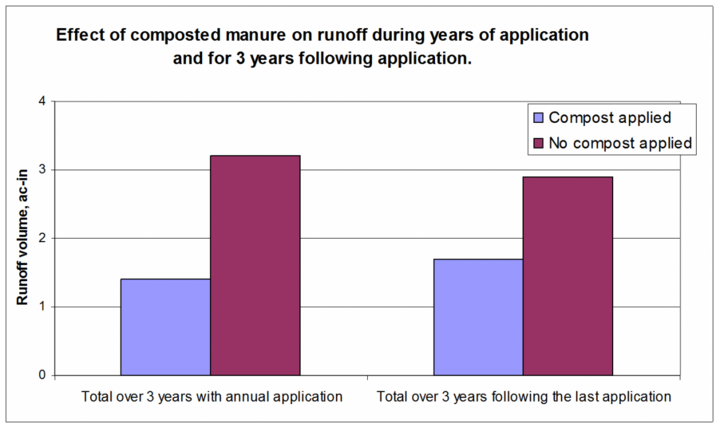
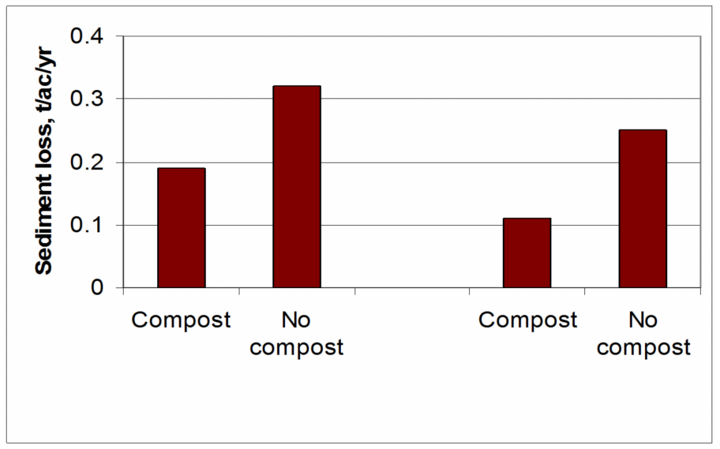
Figure 3. The effect of composted feedlot manure applied to a silt loam in eastern Nebraska on runoff and soil loss during three years of application and the following four years.
Gypsum
Gypsum is calcium sulfate dihydrate and may be available from mining or industrial by-products.
Gypsum has several possible agricultural uses as a soil amendment (Franzen et al 2006). It can:
- provide calcium and sulfur;
- mitigate soil acidity in aluminum-dominated soils (less than pH 4.5);
- reclaim sodic soils (dispersed soils high in sodium) where leaching is feasible;
- improve soil aggregation and water percolation for some soils;
- reduce soil crusting an reduce runoff;
- decrease soil pH in high-pH soils (more than pH 8.5); and
- decrease iron chlorosis in some soils.
The Natural Resource Conservation Service (NRCS) adopted Conservation Practice Standard 333 to include application of gypsum as a practice for improving soil health and surface water quality (USDA-NRCS, 2015).
Following the Clean Air Act, some coal-burning power plants adopted a type of flue scrubber that results in a calcium sulfate by-product referred to as flue gas desulfurization (FGD) gypsum. The effects of FGD gypsum on corn yields were evaluated in an on-farm trial near Trumbull, Nebr. with treatment strips situated to cover much soil variability (Figure 4). The FGD gypsum was applied at 0, 1.12, 4.48 and 8.96 Mg ha-1 in early April 2014. Corn grain was increased with FGD gypsum application in the areas of the field that had either low soil pH, soil organic matter, or both. This could be likely due to nutrient benefits as well as liming effect of FGD gypsum in parts of this field.
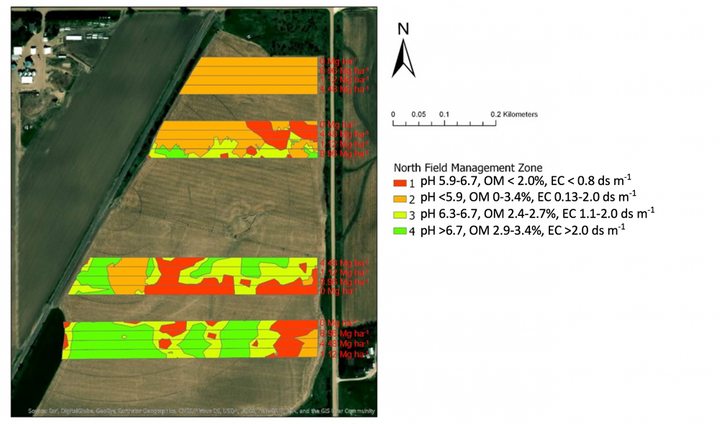
However, gypsum use needs to be well targeted to problems and field conditions. In a study at multiple sites in watersheds draining to the Great Lakes, FGD gypsum application did not improve soil bulk density, penetration resistance, hydraulic conductivity, or aggregate stability (Buckley and Wolkowski, 2014). In contrast, gypsum application at about 2 tons/acre to high sodium soils increased water infiltration and reduced surface runoff and erosion (Keren et al., 1983; Morin and Van Winkel, 1996). Generally, if soils are not dispersive, gypsum application does not increase water infiltration (Ben-Hur et al., 1992). Sindelar and Wolkowski (2019) found FGD gypsum reduced water soluble P in the top 5 cm of soil in fields with high soil test P and low CEC (Figure 5).
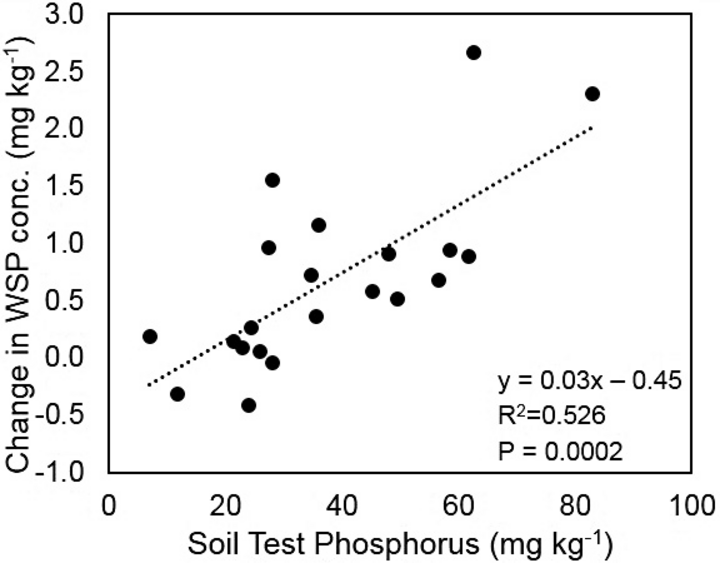
The heavy metal content of FGD gypsum can be high enough to consider laboratory test results in deciding on its use and application rates.
Biochar and Char
Biochar is a carbon-rich organic material derived from pyrolysis of biomass. Biochar, depending on sources and production conditions and subsequent characteristics, can benefit soil properties and crop yields. The presence of nutrients and C, and its porosity with large reactive surface area, makes biochar a potential soil amendment. However, use of biochar can be cost prohibitive. Its benefits are expected to be greatest with soil of low cation exchange capacity, weak aggregate stability, and less available water-holding capacity.
Char remnants of coal combustion for sugar beet processing in Scottsbluff, Nebr. contain up to 30% total C and other essential plant mineral nutrients. Optimum rates of coal char reduced ammonia volatilization losses in fertilized sandy loam and loam soil in a laboratory study (Figure 6). Due to combined effects of high surface area of 82 m2 g-1, high CEC of 47 meq/100g, and coarse texture, char seemed to have retained nutrients in soils and thus reduced volatilization loss. In fields with exposed subsoils or low soil organic matter, char has increased crop yields.
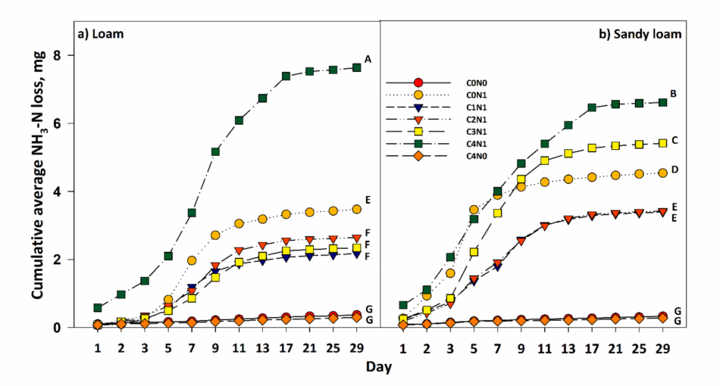
Lime
Most field crops perform best at a soil pH between 6.0 and 6.8. Liming can neutralize yield-limiting soil acidity. Full payoff may require three to four years and yield increases are expected to be greater with soybean than with corn. Guidelines on soil amendment with lime are given in the UNL NebGuide, Lime Use for Soil Acidity Management G1504 (Mamo et al., 2015).
Conclusion
Amendments are beneficial to soil properties and crop productivity when well targeted to specific problems under specific field conditions. Site-specific use of soil amendments may improve returns from investment.
References
Blanco-Canqui, H., G.W. Hergert, and R.A. Nielsen. 2015. Cattle manure application reduces soil compactibility and increases water retention after 71 years. Soil Science Society of American Journal. 79:212-223.
Ben-Hur, M., R. Stern, A.J. van der Merwe, and I. Shainberg. 1992. Slope and gypsum effects on infiltration and erodibility of dispersive and nondispersive soils. Soil Science Society of America Journal 56:1571-1576.
Buckley, M.E., and R.P. Wolkowski. 2014. In-season effect of flue gas desulfurization gypsum on soil physical properties. Journal of Environmental Quality. 43:322-327.
Franzen, D., G. Rehm, and J. Gerwing. 2006. Effectiveness of gypsum in the North-central region of the U.S. NDSU Extension Service SF-1321.
Keren, R., I. Shainberg, H. Frenkel, and Y. Kalo. 1983. The effect of exchangeable sodium and gypsum on surface runoff from loess soil. Soil Science Society of America Journal 47:1001-1004.
Mamo, M., C.S. Wortmann, and C.A. Shapiro. 2015. Lime use for soil acidity management. University of Nebraska-Lincoln. NebGuide G1504
Morin, J., and J. Van Winkel. 1996. The effect of raindrop impact and sheet erosion on infiltration rate and crust formation. Soil Science Society of America Journal 60:1223-1227.
Shapiro, C.A., L. Johnson, A. M. Schmidt, and R.K. Koelsch. 2015. Determining crop available nutrients from manure. University of Nebraska-Lincoln. NebGuide G1335
Sindelar, M.E., and R.P. Wolkowski. 2019. Reducing water-soluble phosphorus in soil through flue gas desulfurization gypsum application: year of application effects at multiple sites in Wisconsin. Journal of Environmental Quality. doi:10.2134/jeq2018.05.0217
USDA-NRCS. 2015. Amending soil properties with gypsum products. Conservation practice standard. 333-CPS:1-5.
Wortmann, C.S. and D.T. Walters. 2006. Phosphorus runoff during four years following composted manure application. Journal of Environmental Quality. 35:651-657.
Wortmann, C.S. and D.T. Walters. 2007. Residual effects of compost and plowing on phosphorus and sediment in runoff. Journal of Environmental Quality. 36(5):1521-1527.
Wortmann, C.S. and C.A. Shapiro. 2008. The effects of manure application on soil aggregation. Nutrient Cycling in Agroecosystems. 80(2):173-180.
